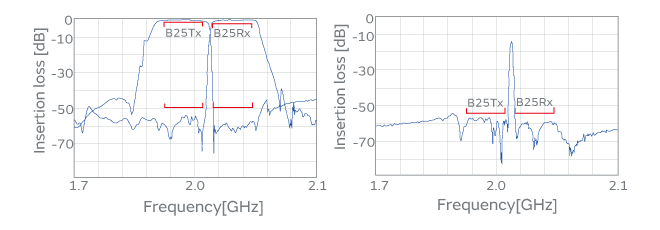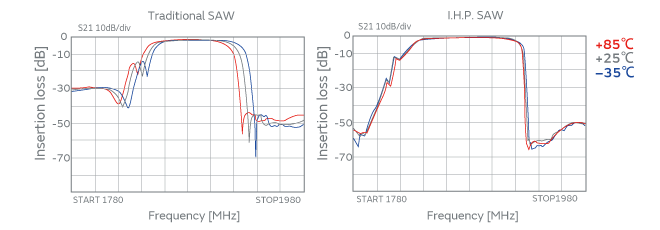2. Characteristic Features of the I.H.P. SAW Filters
The I.H.P. SAW filters are surface acoustic wave devices characterized by (1) high Q factor, (2) low temperature coefficient of frequency, or TCF, and (3) high heat dissipation.
(1) High Q Factor
The I.H.P. SAW filters can realize high Q factor characteristics. The filters adopt a structure that makes the energy of surface acoustic waves focus on the surface of the substrate, allowing the lossless propagation of the wave over the substrate. The peak value of the Q characteristics, or Qmax, of a resonator prototype exceeded 3,000 at the 1.9 GHz band, which was a substantial improvement as compared with traditional SAW filters, of which Qmax is typically about 1,000.
Figure 3 shows an instance of the I.H.P. SAW application to an RF filter. The targeted band is band 25, a band that has been considered the most difficult to deal with. Satisfactory characteristics were obtained in the actual measurements: The typical values of the insertion loss were Tx: 1.5 dB and Rx: 2.1 dB, and the typical values of the isolation were TxIso: 57 dB and RxIso: 59 dB. The results indicate an applicability of this new filter to the highly difficult band 25.

(2) Low TCF
The I.H.P. SAW filters can improve frequency-temperature characteristics. The filters accomplish satisfactory temperature characteristics by simultaneously controlling the linear expansion coefficient of the substrate and the speed of sound. Figure 4 shows the filter characteristics when the temperature was changed from -35°C to +85°C. Traditional SAW filters exhibit a very large shift of about -40 ppm/°C in TCF, whereas the I.H.P. SAW filters can exhibit an improved shift of ±8 ppm/°C or less. This improvement of TCF by about 30 ppm/°C can further be improved to 0 ppm/°C by appropriately designing the structure of the substrate.

The TCF of the I.H.P. SAW filters is better than that of the BAW filters. The TCF of common BAW filters is in the range of -20 to 30 ppm/°C. So, the I.H.P. SAW filters realize better temperature characteristics than the BAW filters in terms of the TCF. The low TCF characteristic features of the I.H.P. SAW filters will be a huge advantage in designing the filters in the recent trend of even stricter demand for better temperature characteristics.






